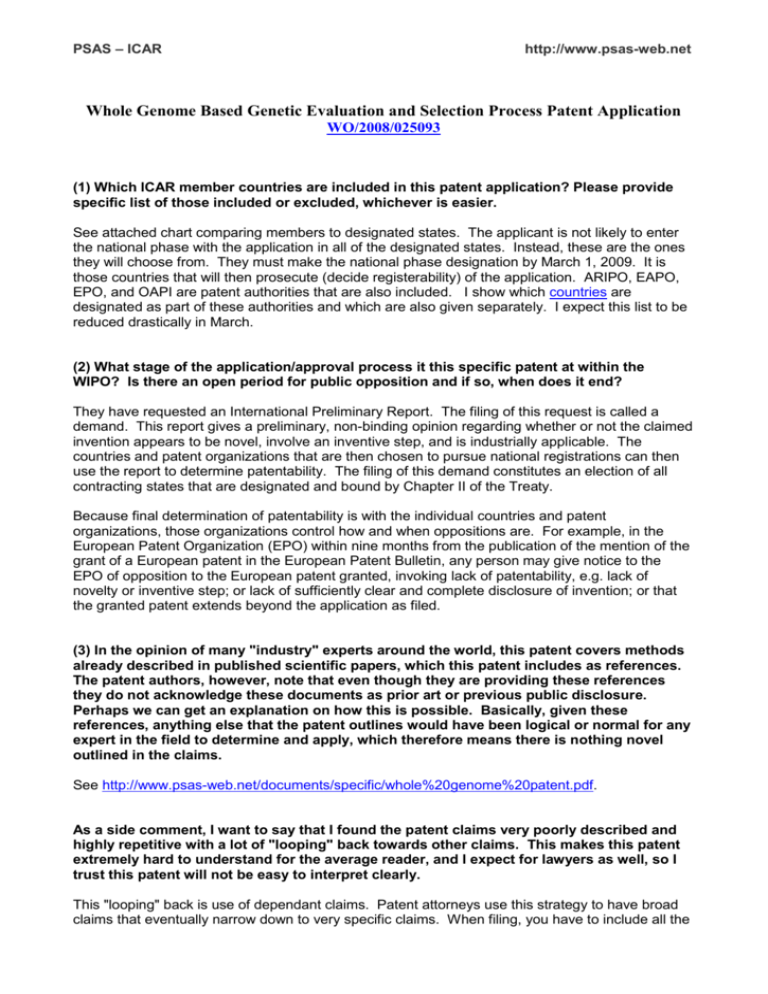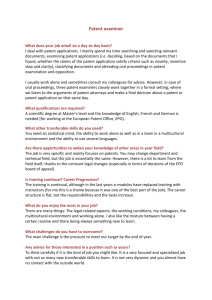Whole Genome Based Genetic Evaluation and Selection
advertisement

PSAS – ICAR http://www.psas-web.net Whole Genome Based Genetic Evaluation and Selection Process Patent Application WO/2008/025093 (1) Which ICAR member countries are included in this patent application? Please provide specific list of those included or excluded, whichever is easier. See attached chart comparing members to designated states. The applicant is not likely to enter the national phase with the application in all of the designated states. Instead, these are the ones they will choose from. They must make the national phase designation by March 1, 2009. It is those countries that will then prosecute (decide registerability) of the application. ARIPO, EAPO, EPO, and OAPI are patent authorities that are also included. I show which countries are designated as part of these authorities and which are also given separately. I expect this list to be reduced drastically in March. (2) What stage of the application/approval process it this specific patent at within the WIPO? Is there an open period for public opposition and if so, when does it end? They have requested an International Preliminary Report. The filing of this request is called a demand. This report gives a preliminary, non-binding opinion regarding whether or not the claimed invention appears to be novel, involve an inventive step, and is industrially applicable. The countries and patent organizations that are then chosen to pursue national registrations can then use the report to determine patentability. The filing of this demand constitutes an election of all contracting states that are designated and bound by Chapter II of the Treaty. Because final determination of patentability is with the individual countries and patent organizations, those organizations control how and when oppositions are. For example, in the European Patent Organization (EPO) within nine months from the publication of the mention of the grant of a European patent in the European Patent Bulletin, any person may give notice to the EPO of opposition to the European patent granted, invoking lack of patentability, e.g. lack of novelty or inventive step; or lack of sufficiently clear and complete disclosure of invention; or that the granted patent extends beyond the application as filed. (3) In the opinion of many "industry" experts around the world, this patent covers methods already described in published scientific papers, which this patent includes as references. The patent authors, however, note that even though they are providing these references they do not acknowledge these documents as prior art or previous public disclosure. Perhaps we can get an explanation on how this is possible. Basically, given these references, anything else that the patent outlines would have been logical or normal for any expert in the field to determine and apply, which therefore means there is nothing novel outlined in the claims. See http://www.psas-web.net/documents/specific/whole%20genome%20patent.pdf. As a side comment, I want to say that I found the patent claims very poorly described and highly repetitive with a lot of "looping" back towards other claims. This makes this patent extremely hard to understand for the average reader, and I expect for lawyers as well, so I trust this patent will not be easy to interpret clearly. This "looping" back is use of dependant claims. Patent attorneys use this strategy to have broad claims that eventually narrow down to very specific claims. When filing, you have to include all the PSAS – ICAR http://www.psas-web.net claims you will eventually want. At that time, however, you do not know which points the examiner will find patentable and which he will not. Therefore, you write claims for all possible versions and let the examiner cut out the ones that will not be registered. Sometimes, if there are a lot of variations and layers, the dependant claims can get a bit messy and yes, difficult to read and follow. This document provides general guidance about the titled subject, is not to be regarded as legal advice, and does not create an attorney-client relationship between Murphy Desmond S.C. or Erin R. Ogden and the reader. Because the information herein may become outdated or may not apply to your specific circumstance, it should not be relied upon or used in place of a detailed consultation with a professional advisor. If you would like to know how this could apply to your specific circumstances, please consult a licensed attorney in the correct jurisdiction.






